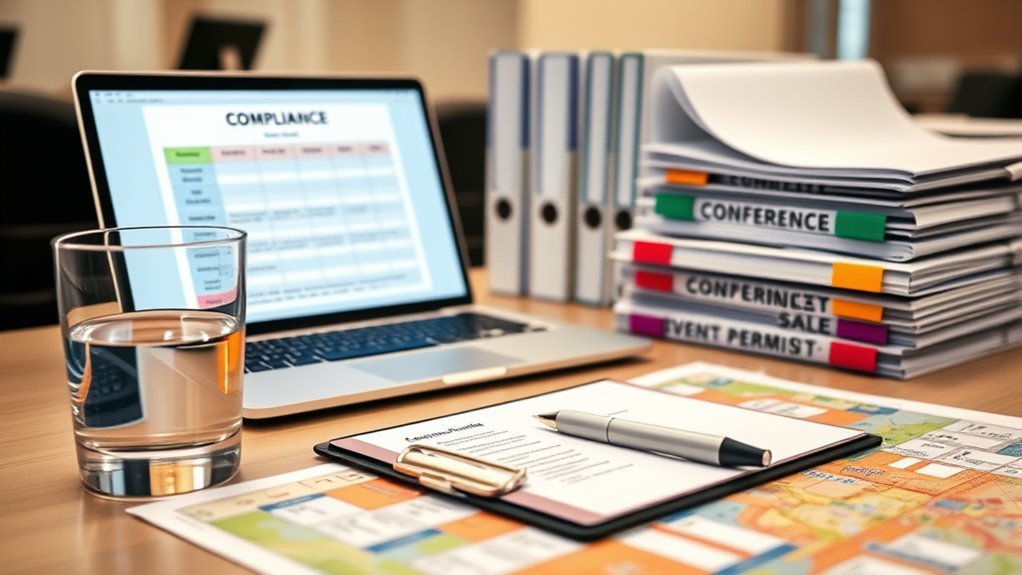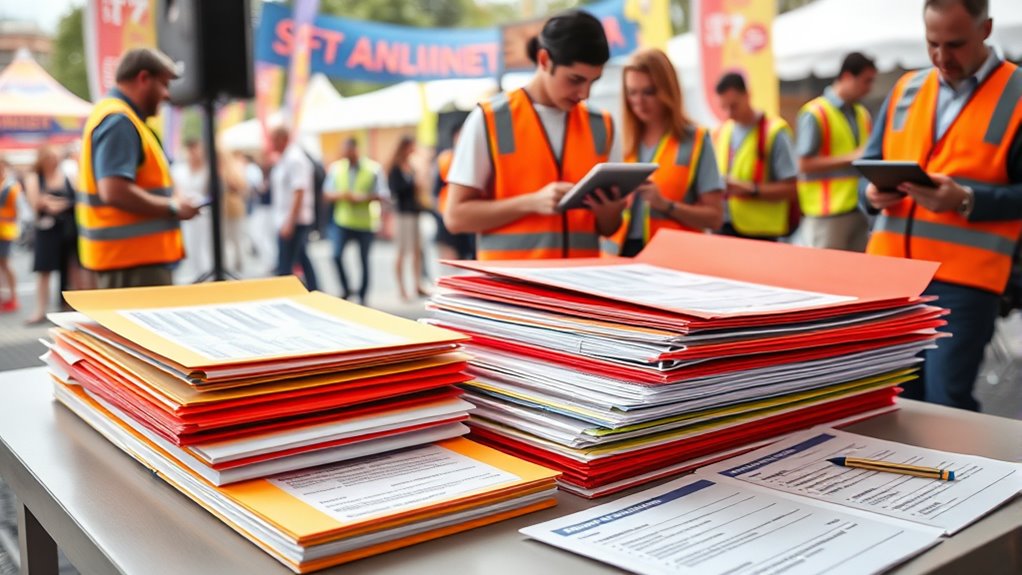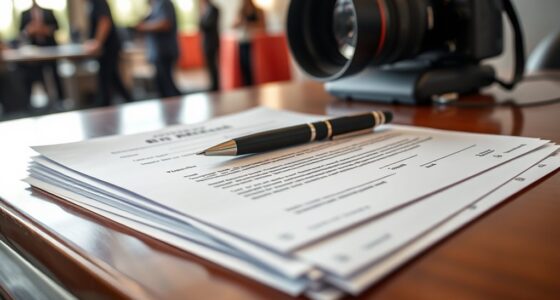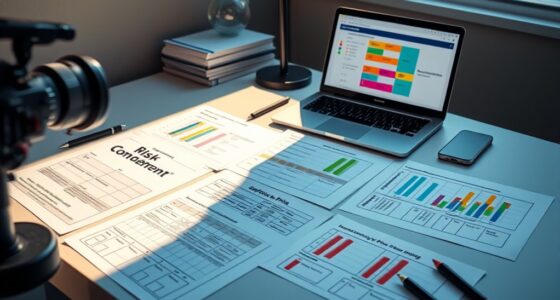To guarantee your public event complies with legal requirements, you need to gather and keep detailed documentation like permits, safety plans, and risk assessments. Make certain all permits—such as special event, noise, and health permits—are obtained early and properly filed. Maintain records of safety protocols, insurance proof, and correspondence with authorities. Staying organized helps you respond easily to inspections and legal inquiries. Continue exploring to learn more about creating a thorough compliance toolkit for your event.
Key Takeaways
- Maintain detailed records of all permits, safety plans, correspondence, and risk assessments related to the event.
- Ensure all required permits (special event, health, noise) are obtained and documented before the event.
- Keep proof of insurance coverage aligned with permit requirements to demonstrate legal compliance.
- Regularly update and organize documentation as event plans evolve to reflect current compliance status.
- Collaborate with local authorities and retain communication records to support inspection readiness and legal adherence.

Have you ever wondered what it takes to host a successful public event while staying within legal boundaries? One of the most critical aspects is understanding permit requirements and safety protocols. Securing the necessary permits isn’t just a bureaucratic step; it’s a vital component of ensuring your event runs smoothly and legally. Different types of events—whether they’re festivals, concerts, or community gatherings—may require various permits, such as special event permits, health and safety permits, or noise permits. Failing to obtain the correct documentation can lead to fines, event cancellations, or even legal action. That’s why it’s essential to start early, review local regulations, and communicate with the relevant authorities to ensure you meet all permit requirements.
Understanding permit requirements is essential for hosting legal, safe, and successful public events.
Once you’ve identified which permits are necessary, you need to develop robust safety protocols. These protocols serve as the backbone of your event’s safety plan and are often scrutinized during the permit approval process. Safety protocols include crowd control measures, emergency response plans, fire safety procedures, and accessibility accommodations. You should work closely with local agencies—such as fire departments, police, and health officials—to align your safety measures with their standards. This collaboration not only helps in obtaining permits but also reassures authorities that your event prioritizes attendee safety. Remember, safety isn’t just about compliance; it’s about protecting everyone involved.
Documentation plays a crucial role in demonstrating your adherence to permit requirements and safety protocols. Keep detailed records of all permits obtained, correspondence with authorities, safety plans, and risk assessments. Having everything organized and accessible makes it easier to respond to inspections or inquiries and provides proof of your compliance efforts. It’s also a good idea to update these documents as your plans evolve, ensuring that your paperwork always reflects the current state of your preparations. Additionally, understanding the legal framework surrounding event safety and permits can help you better navigate the process and avoid potential pitfalls.
In addition, some permits may require proof of insurance coverage, which safeguards you from financial liabilities in case of accidents or damages during the event. Providing evidence of insurance coverage is often a condition of permit approval, so make sure your policy is comprehensive and up to date. By thoroughly understanding permit requirements and implementing rigorous safety protocols, you create a solid foundation for your event’s success. Not only does this reduce legal risks, but it also builds trust with your attendees, staff, and local authorities. Ultimately, diligent compliance documentation ensures your event is both enjoyable and lawful, paving the way for future successful gatherings.
Frequently Asked Questions
How Early Should Compliance Documentation Be Prepared for a Public Event?
You should start preparing compliance documentation at least six to eight weeks before your public event. This allows ample time for timeline planning and thorough documentation review. Early preparation helps you identify potential issues, gather necessary approvals, and guarantee everything aligns with regulations. By starting early, you reduce last-minute stress and increase the likelihood of a smooth, compliant event. Remember, proactive planning makes the process much more manageable.
Who Is Responsible for Verifying Compliance Documentation on the Event Day?
On the event day, you are responsible for verifying compliance documentation through your event staff during compliance checks. For example, imagine a music festival where staff double-check permits and safety plans before opening gates. You confirm each team member knows their role, actively inspecting documents, and addressing any issues promptly. This proactive approach helps prevent violations, keeps the event running smoothly, and guarantees all legal and safety standards are met.
What Are the Common Penalties for Non-Compliance?
You face liability penalties and documentation fines if you don’t guarantee compliance with event regulations. Common penalties include hefty fines, suspension of event permits, or even legal action. To avoid these, you must verify that all required documentation is accurate, complete, and submitted on time. Failing to do so can result in significant financial and legal consequences, impacting your ability to host future events and damaging your reputation.
Can Compliance Documentation Be Updated After Submission?
Yes, you can update compliance documentation after submission by following the amendment procedures outlined by authorities. These procedures guarantee the documentation remains valid and reflects the most current information. You should submit the amended documents promptly and ensure they are reviewed and approved to maintain compliance validity. Keeping your documentation up-to-date demonstrates ongoing adherence to regulations and helps avoid potential penalties or event disruptions.
Are There Different Requirements for Private vs. Public Events?
You should know that private and public events often have different compliance requirements. For instance, 60% of public events face stricter accessibility standards to guarantee inclusivity. You must address confidentiality concerns carefully for both, but public events typically demand more detailed documentation due to higher attendee visibility. Always check specific guidelines, as meeting accessibility standards and safeguarding sensitive info are vital for both types of events.
Conclusion
Ensuring proper compliance documentation for your public event protects you from legal issues and builds trust with attendees. For instance, imagine organizing a music festival that includes food vendors and large crowds; having all permits and safety plans in place guarantees smooth operations and quick responses to emergencies. By proactively managing your documentation, you demonstrate professionalism and safeguard your event’s success, making compliance an essential part of your planning process.









